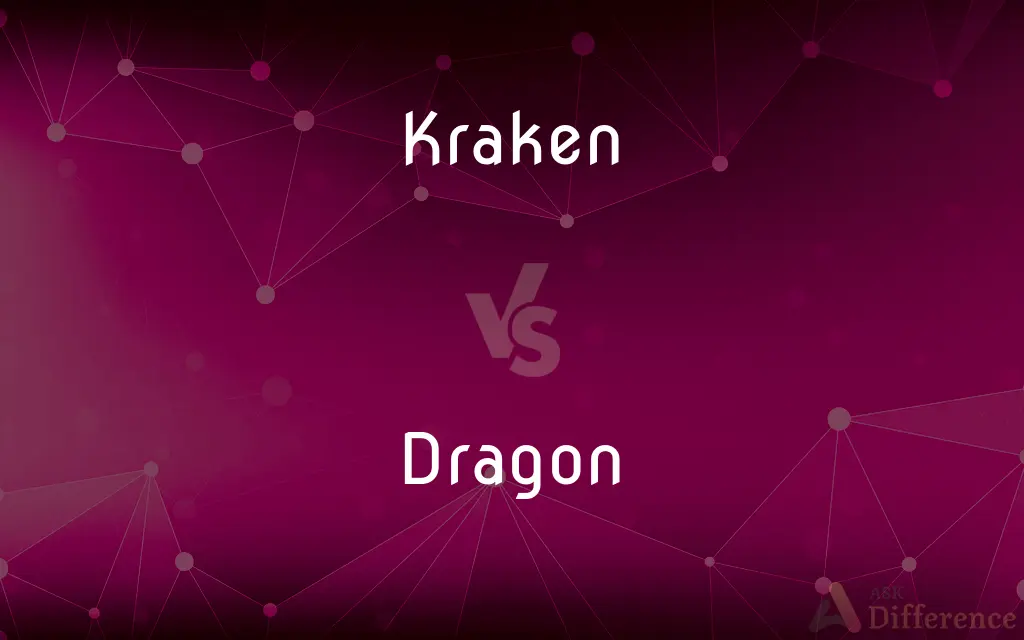Kraken vs. Dragon — What's the Difference?
By Maham Liaqat & Fiza Rafique — Updated on March 27, 2024
The Kraken is a mythical sea monster often depicted as a giant octopus or squid, feared by sailors, while dragons are legendary creatures symbolizing power and often possess the ability to fly and breathe fire.

Difference Between Kraken and Dragon
Table of Contents
ADVERTISEMENT
Key Differences
The Kraken originates from Scandinavian folklore, primarily depicted as a massive sea creature capable of engulfing ships and sailors alike. This legend likely stems from sightings of real giant squids, magnified through the lens of seafaring lore. On the other hand, dragons have roots in various cultures worldwide, from the winged and fire-breathing varieties in Western mythology to the more serpentine and spiritually significant versions in Eastern traditions.
Krakens are specifically maritime entities, embodying the dangers and mysteries of the ocean. Their tales are often tied to specific regions of the sea, warning of perilous waters. Dragons, however, are more versatile in mythological settings, found in the air, on land, and occasionally in water. They can be protectors, wise beings, or destructive forces, depending on the cultural context.
While the Kraken is singular in its representation as a sea monster of colossal size, dragons vary widely in appearance and abilities across different mythologies. Western dragons are typically depicted with reptilian or dinosaur-like traits, capable of flight and spewing fire. Eastern dragons, conversely, are often seen as benevolent, snake-like creatures with no wings but can fly and control weather phenomena, especially rain and storms.
In storytelling and popular culture, the Kraken is often portrayed as a fearsome antagonist, a creature to be outwitted or defeated by sailors or heroes. Dragons, by contrast, have a more flexible narrative role; they can be wise guardians, symbols of imperial power, destructive adversaries, or even noble companions to human characters.
Despite their distinct origins and characteristics, both the Kraken and dragons have captivated human imagination, symbolizing the unknown and the elemental forces of nature. They serve as reminders of the awe-inspiring and terrifying aspects of the natural world, whether it be the depth of the oceans or the expanse of the sky.
ADVERTISEMENT
Comparison Chart
Origin
Scandinavian folklore
Global, with significant presence in both Western and Eastern myths
Habitat
Ocean
Varied: land, sea, and sky
Appearance
Giant octopus or squid
Reptilian, can be winged, varies significantly between cultures
Abilities
Engulfing ships, creating whirlpools
Flying, breathing fire (in many Western myths), controlling weather (in Eastern myths)
Symbolism
Dangers of the sea
Power, wisdom, or malevolence, depending on the culture
Compare with Definitions
Kraken
A mythical sea monster of gigantic size, feared for sinking ships.
Sailors whispered tales of the Kraken, lurking in the dark waters of the North Sea.
Dragon
A legendary creature found in various cultures, often capable of breathing fire.
The dragon guarded the castle, breathing fire at anyone who dared approach.
Kraken
Often depicted as a giant octopus or squid.
Legends describe the Kraken with tentacles vast enough to pull entire vessels into the abyss.
Dragon
Can represent wisdom, power, or a formidable challenge.
In Eastern traditions, dragons symbolized wisdom and were thought to bring rain to the earth.
Kraken
Symbolizes the unpredictability and danger of the sea.
In folklore, the Kraken was a reminder of the ocean's unfathomable power and mystery.
Dragon
Depicted in many forms, from winged serpents to massive, fire-breathing reptiles.
The Eastern dragon, a wingless serpent, soared through the skies, commanding the winds and storms.
Kraken
The kraken () is a legendary sea monster of gigantic size and cephalopod-like appearance in Scandinavian folklore. According to the Norse sagas, the kraken dwells off the coasts of Norway and Greenland and terrorizes nearby sailors.
Dragon
A dragon is a large, serpentine, legendary creature that appears in the folklore of many cultures worldwide. Beliefs about dragons vary considerably through regions, but dragons in western cultures since the High Middle Ages have often been depicted as winged, horned, four-legged, and capable of breathing fire.
Kraken
An enormous mythical sea monster said to appear off the coast of Norway.
Dragon
See Draco2.
Kraken
A huge sea monster in Norwegian legend.
Dragon
A mythical monster traditionally represented as a gigantic reptile having a long tail, sharp claws, scaly skin, and often wings.
Kraken
A fabulous Scandinavian sea monster, often represented as resembling an island, but sometimes as resembling an immense octopus.
To believe all that has been said of the sea serpent or kraken, would be credulity; to reject the possibility of their existence, would be presumption.
Like a kraken huge and black.
Dragon
Any of various lizards, such as the Komodo dragon or the flying lizard.
Dragon
A fiercely vigilant or intractable person.
Dragon
Something very formidable or dangerous.
Dragon
(Archaic) A large snake or serpent.
Dragon
A legendary serpentine or reptilian creature.
Dragon
In Western mythology, a gigantic beast, typically reptilian with leathery bat-like wings, lion-like claws, scaly skin and a serpent-like body, often a monster with fiery breath.
Dragon
In Eastern mythology, a large, snake-like monster with the eyes of a hare, the horns of a stag and the claws of a tiger, usually beneficent.
Dragon
An animal of various species that resemble a dragon in appearance:
Dragon
(obsolete) A very large snake; a python.
Dragon
Any of various agamid lizards of the genera Draco, Physignathus or Pogona.
Dragon
A Komodo dragon.
Dragon
The constellation Draco.
Dragon
(pejorative) A fierce and unpleasant woman; a harridan.
She’s a bit of a dragon.
Dragon
The (historical) Chinese empire or the People's Republic of China.
Napoleon already warned of the awakening of the Dragon.
Dragon
(figuratively) Something very formidable or dangerous.
Dragon
A type of playing-tile (red dragon, green dragon, white dragon) in the game of mahjong.
Dragon
A luminous exhalation from marshy ground, seeming to move through the air like a winged serpent.
Dragon
A short musket hooked to a swivel attached to a soldier's belt; so called from a representation of a dragon's head at the muzzle.
Dragon
A background process similar to a daemon.
Dragon
A variety of carrier pigeon.
Dragon
(slang) A transvestite man, or more broadly a male-to-female transgender person.
Dragon
A fabulous animal, generally represented as a monstrous winged serpent or lizard, with a crested head and enormous claws, and regarded as very powerful and ferocious.
The dragons which appear in early paintings and sculptures are invariably representations of a winged crocodile.
Thou breakest the heads of the dragons in the waters.
Thou shalt tread upon the lion and adder; the young lion and the dragon shalt thou trample under feet.
He laid hold on the dragon, that old serpent, which is the Devil and Satan, and bound him a thousand years.
Dragon
A fierce, violent person, esp. a woman.
Dragon
A constellation of the northern hemisphere figured as a dragon; Draco.
Dragon
A luminous exhalation from marshy grounds, seeming to move through the air as a winged serpent.
Dragon
A short musket hooked to a swivel attached to a soldier's belt; - so called from a representation of a dragon's head at the muzzle.
Dragon
A small arboreal lizard of the genus Draco, of several species, found in the East Indies and Southern Asia. Five or six of the hind ribs, on each side, are prolonged and covered with weblike skin, forming a sort of wing. These prolongations aid them in making long leaps from tree to tree. Called also flying lizard.
Dragon
A variety of carrier pigeon.
Dragon
A fabulous winged creature, sometimes borne as a charge in a coat of arms.
Dragon
A creature of Teutonic mythology; usually represented as breathing fire and having a reptilian body and sometimes wings
Dragon
A fiercely vigilant and unpleasant woman
Dragon
A faint constellation twisting around the north celestial pole and lying between Ursa Major and Cepheus
Dragon
Any of several small tropical Asian lizards capable of gliding by spreading winglike membranes on each side of the body
Common Curiosities
Are dragons always portrayed as evil creatures?
No, dragons can be depicted as malevolent or benevolent, protectors or challengers, depending on the cultural narrative.
Why do people continue to be fascinated by Krakens and dragons?
These creatures symbolize the unknown and the power of nature, stirring the human imagination with their mystery and majesty.
Is there a cultural significance to the way dragons are portrayed?
Yes, the portrayal of dragons often reflects cultural values and beliefs, such as power, wisdom, or natural forces.
What role do Krakens play in maritime folklore?
Krakens embody the perils of seafaring, serving as cautionary tales of the dangers lurking in uncharted waters.
Can Krakens breathe fire like some dragons?
No, Krakens are not associated with fire-breathing; their terror comes from their immense size and strength in the water.
Do any legends suggest that Krakens and dragons interact?
Most traditional myths treat Krakens and dragons as separate entities, with no interaction between them.
Are Krakens real or mythical creatures?
The Kraken is a mythical creature, though its legend may have been inspired by real encounters with giant squids.
Do dragons exist in various cultures around the world?
Yes, dragons are a common element in the mythology of many cultures, with their characteristics and symbolism varying greatly.
Have Krakens and dragons been depicted in modern media?
Yes, both have been featured in books, movies, video games, and television shows, highlighting their enduring appeal.
How do depictions of dragons differ between Western and Eastern myths?
Western dragons are often winged and fire-breathing, symbolizing challenges to be overcome, while Eastern dragons are wingless, wise, and associated with natural elements, particularly water.
Share Your Discovery

Previous Comparison
Acknowledgement vs. Dedication
Next Comparison
Misconnection vs. DisconnectionAuthor Spotlight
Written by
Maham LiaqatCo-written by
Fiza RafiqueFiza Rafique is a skilled content writer at AskDifference.com, where she meticulously refines and enhances written pieces. Drawing from her vast editorial expertise, Fiza ensures clarity, accuracy, and precision in every article. Passionate about language, she continually seeks to elevate the quality of content for readers worldwide.














































